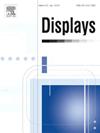Quantifying the impact of night-shift display modes on evening melatonin production
IF 3.7
2区 工程技术
Q1 COMPUTER SCIENCE, HARDWARE & ARCHITECTURE
引用次数: 0
Abstract
The use of self-emitting devices in the evening can significantly suppress melatonin secretion, leading to sleep onset delays and circadian disruption. To minimize these undesirable effects, various night-shift display modes have been developed. In this study, we conducted a human factor experiment to investigate the effectiveness of night-shift modes in maintaining evening melatonin production. The study adopted four different night-shift modes and a normal mode for smartphones, which were applied during the three hours before bedtime. The four different night-shift modes employed constant and dynamically reduced correlated color temperatures (CCTs) and luminance levels. Under modes with constant low luminance and CCTs (leading to low melanopic lux), participants had significantly higher melatonin production than those in the normal mode (with high melanopic lux). This result indicates that a reduction in melanopic lux is effective in mitigating the negative effect of display light on evening melatonin production. Regarding the dynamic modes, despite achieving lower melanopic lux levels before sleep, they exhibited relatively high melanopic lux during the early hours of the experiment. Thus, it is necessary to quantify the cumulative time effects of melanopic lux over various periods when evaluating its impact on melatonin production. It was found that the cumulative Melanopic Equivalent Daylight Illuminance (ʃ m-EDI dt) over two hours before bedtime could be an effective metric, which applies to both dynamic and static display modes. Based on the metric, a value below 35 lx·h in the evening is considered effective in reducing the attenuation of melatonin production.
求助全文
约1分钟内获得全文
求助全文
来源期刊

Displays
工程技术-工程:电子与电气
CiteScore
4.60
自引率
25.60%
发文量
138
审稿时长
92 days
期刊介绍:
Displays is the international journal covering the research and development of display technology, its effective presentation and perception of information, and applications and systems including display-human interface.
Technical papers on practical developments in Displays technology provide an effective channel to promote greater understanding and cross-fertilization across the diverse disciplines of the Displays community. Original research papers solving ergonomics issues at the display-human interface advance effective presentation of information. Tutorial papers covering fundamentals intended for display technologies and human factor engineers new to the field will also occasionally featured.
 求助内容:
求助内容: 应助结果提醒方式:
应助结果提醒方式:


